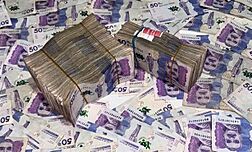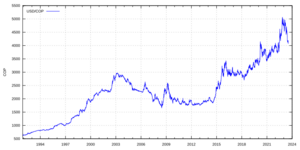Colombian peso facts for kids
Quick facts for kids Colombian peso |
|||
|---|---|---|---|
|
|||
| ISO 4217 Code | COP | ||
| Official user(s) | |||
| Unofficial user(s) | |||
| Inflation | 7.18% (June 2024) | ||
| Subunit | |||
| 1⁄100 | centavo (Discontinued in 1984) |
||
| Symbol | $ | ||
| Coins | |||
| Freq. used | $100, $200, $500, $1,000 | ||
| Banknotes | |||
| Freq. used | $2,000, $5,000, $10,000, $20,000, $50,000, $100,000 | ||
The Colombian peso (symbol: $; code: COP) is the official money used in Colombia. Its special code is COP. The common symbol for the peso is $. Sometimes, people use Col$ to show it's the Colombian peso and not another currency like the dollar.
One peso used to be divided into one hundred centavos. However, because prices went up a lot in the 1970s and 1980s, Colombia stopped making centavo coins in 1984. Even though centavo coins are not used daily, people still write amounts with centavos. For example, you might see something priced at $1.50, but you would usually pay $2.00 in cash. This is because most cash payments are rounded to the nearest 100 pesos. Electronic payments, however, can still include centavos.
Contents
History of Colombian Money
Before 1820, when Colombia became independent from Spain, people used the Spanish colonial real. This was replaced by the Colombian real. In 1837, the Colombian real was swapped for the current peso. One peso was equal to 8 reales at that time.
In 1847, Colombia changed its money system to a decimal one. This meant the peso was divided into ten reales, and each real was split into 10 décimos de reales (later called centavos). The idea of 100 centavos making one peso first appeared on banknotes in 1819. It became common on banknotes in the 1860s and on coins by 1872.
In 1871, Colombia linked its peso to the French franc. This meant 1 peso was worth 5 francs. This link lasted until 1886. Later, the value of paper money dropped because too much was printed. From 1910, new banknotes called peso oro were introduced. In 1931, the peso was linked to the United States dollar. This link meant 1.05 pesos were worth 1 dollar. Even so, peso banknotes continued to be called peso oro until 1993.
In 2018, the Congress of Colombia talked about changing the peso. The idea was to remove three zeroes from the value, so 1,000 pesos would become 1 new peso. This would make counting and banking easier. New banknotes were already introduced in 2016 with "mil" (thousand) written instead of the last three zeroes. This would have made it easy to change "mil" to "nuevos" (new). The president at the time, Juan Manuel Santos, supported this idea. However, many people were against it because it would cost a lot of money and might confuse people. The next president, Iván Duque, did not support the change, so the idea is not being considered now.
Colombian Coins
Colombia has had many different coins throughout its history. Early coins in the 1830s were in silver and gold. When the currency became decimal in 1847, new coins like the décimo de real were introduced.
Over the years, coins were issued by different governments, including the Granadine Confederation and the United States of Colombia. In 1872, centavo coins were first made.
In the early 1900s, new coins were introduced, including gold coins that were similar in value to British gold coins. As time went on, the materials used for coins changed from silver to copper-nickel and bronze.
Due to high inflation, the value of money changed a lot. Coins with higher values like 5, 10, 20, 50, 100, 200, 500, and even 1,000 pesos were introduced. However, the 1,000 peso coin was taken out of use because of too many fake coins. By 2009, smaller coins like 5, 10, and 20 pesos were no longer made often. This is why most cash payments are rounded to the nearest 100 pesos.
In 2012, the Bank of the Republic of Colombia released a new series of coins. The 500 and 1,000 peso coins in this series are Bi-metallic coins, meaning they are made of two different metals.
| 2012 Coin Series | |||||||||
|---|---|---|---|---|---|---|---|---|---|
| Image | Value | Technical parameters | Description | ||||||
| Obverse | Reverse | Diameter | Thickness | Mass | Composition | Edge | Obverse | Reverse | |
 |
 |
50 pesos | 17 mm | 1.3 mm | 2.0 g | Nickel-plated steel | Plain | The spectacled bear, its popular name, and scientific name. | Value, bordered with the words "Republic of Colombia" and the year of minting. |
 |
 |
100 pesos | 20.3 mm | 1.55 mm | 3.34 g | Brass-plated steel 90.8% iron, 1.2% carbon; Layers: 6.4%-7.2% copper, 3.2%-2.4% zinc |
Plain | The frailejón, its popular name, and scientific name. | Value, bordered with the words "Republic of Colombia" and the year of minting. |
 |
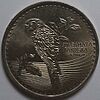 |
200 pesos | 22.4 mm | 1.7 mm | 4.61 g | 65% copper 20% zinc 15% nickel |
Lettered with Plain edge | The scarlet macaw, its popular name, and scientific name. | Value, bordered with the words "Republic of Colombia" and the year of minting. |
 |
 |
500 pesos | 23.7 mm | 2 mm | 7.14 g | Outer Ring: 65% copper 20% zinc 15% nickel Centre Plug: 92% copper 6% aluminium 2% nickel |
Segmented (Plain and Reeded sections) | The glass frog, its popular name, and scientific name. | Value, bordered with the words "Republic of Colombia" and the year of minting. |
 |
 |
1,000 pesos | 26.7 mm | 2.7 mm | 9.95 g | Outer Ring: 92% copper 6% aluminium 2% nickel Centre Plug: 65% copper 20% zinc 15% nickel |
Security | The loggerhead sea turtle, its popular name, and scientific name. | Value, bordered with the words "Republic of Colombia" and the year of minting. |
| Pre-2012 Coin Series | ||||||||
|---|---|---|---|---|---|---|---|---|
| Image | Value | Technical parameters | Description | |||||
| Obverse | Reverse | Diameter | Thickness | Mass | Composition | Obverse | Reverse | |
| 20 pesos | 17.2 mm | 1.15 mm | 2 g | 70% copper 30% zinc |
Simón Bolívar | Value | ||
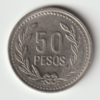 |
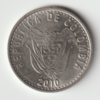 |
50 pesos | 21 mm | 1.3 mm | 4.5 g | 65% copper, 20 % zinc, 15 % nickel |
Coat of arms of Colombia bordered with the words República de Colombia | Value |
 |
 |
100 pesos | 23 mm | 1.55 mm | 5.31 g | aluminium bronze 92% copper 6% aluminium 2% nickel |
Coat of arms of Colombia bordered with the words República de Colombia | Value |
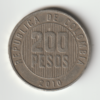 |
 |
200 pesos | 24.4 mm | 1.7 mm | 7.08 g | 65% copper 20% zinc 15% nickel |
Quimbaya civilization figurine | Value |
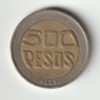 |
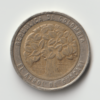 |
500 pesos | 23.5 mm | 2 mm | 7.43 g | Outer Ring: 65% copper 20% zinc 15% nickel Centre Plug: 92% copper 6% aluminium 2% nickel |
Guacarí's tree "El árbol de Guacarí", in recognition of the efforts by the people of Guacarí, Valle del Cauca to preserve the environment and protect the ecology | Value |
Colombian Banknotes
From 1857 to 1880, some of Colombia's regions, like Bolívar and Panama, printed their own paper money. These notes came in different values, from 10 centavos to 100 pesos.
In the early 1860s, banknotes were issued in values like 20 centavos and up to 100 pesos. In 1881, the Banco Nacional (National Bank) started printing notes. Later, in 1904, the Treasury took over making paper money.
More than sixty private banks also printed banknotes between 1865 and 1923.
In 1923, the Banco de la República (Bank of the Republic) became the only place that could print paper money. They introduced notes called peso oro. These notes featured important figures and symbols of Colombia. Over the years, new, higher value notes were introduced as the economy changed. The word oro was removed from the notes in 1993.
In 2006, the 1,000 and 2,000 peso notes were made smaller. This was because they were used a lot and needed to be replaced often. In 2010, the 2,000 peso note was updated to include Braille for people who are visually impaired.
In 2016, the Banco de la República released a brand new series of banknotes. These notes come in values from 2,000 to 100,000 pesos. The 100,000 peso note was the highest value ever introduced. These new banknotes show off Colombia's amazing nature, cultural symbols, and important people from history, science, and politics. They also highlight the important role of women in Colombian society. The new notes were released throughout 2016, starting with the 100,000 peso note in March.
| 2016 Banknote series | |||||||||||
| Image | Value | Dimensions | Background color | Description | Date of | Notes | |||||
|---|---|---|---|---|---|---|---|---|---|---|---|
| Obverse | Reverse | Watermark | first series | Issue | last series | ||||||
| 2,000 pesos | 128 × 66 mm | Blue | Débora Arango | Caño Cristales | The face of painter Débora Arango and the number 2 | 19 August 2015 | 29 November 2016 | ||||
| 5,000 pesos | 133 × 66 mm | Brown | José Asunción Silva | Colombian paramos | The face of poet José Asunción Silva and the number 5 | 19 August 2015 | 9 November 2016 | ||||
| 10,000 pesos | 138 × 66 mm | Red | Virginia Gutiérrez de Pineda | Amazon natural region | The face of anthropologist Virginia Gutiérrez and the number 10 | 19 August 2015 | 7 December 2016 | ||||
| 20,000 pesos | 143 × 66 mm | Orange | Alfonso López Michelsen | La Mojana channels in the region of the Zenú people and the sombrero vueltiao | The face of President Alfonso López Michelsen and the number 20 | 19 August 2015 | 30 June 2016 | ||||
| 50,000 pesos | 148 × 66 mm | Violet | Gabriel García Márquez | Lost City (core of the culture tayrona) | The face of Nobel Prize winner, Gabriel García Márquez and the number 50 | 19 August 2015 | 19 August 2016 | ||||
| 100,000 pesos | 153 × 66 mm | Green | Carlos Lleras Restrepo | Wax palm in Cocora valley, Quindío; Barranquero bird; Luis Vidales's poem about wax palm; Liberty head bank seal |
|
8 August 2014 | 31 March 2016 | ||||
| Pre-2016 Banknote series | |||||||||||
| Image | Value | Dimensions | Background color | Description | Date of | Notes | |||||
|---|---|---|---|---|---|---|---|---|---|---|---|
| Obverse | Reverse | Watermark | first series | Issue | last series | ||||||
| 1,000 pesos | 130 × 65 mm | Orange | Jorge Eliécer Gaitán | Jorge Eliécer Gaitán (upper-half body) and a crowd | Jorge Eliécer Gaitán | August 7, 2001 | November 17, 2001 | ||||
| 2,000 pesos | 130 × 65 mm | Green and beige | Francisco de Paula Santander | The door of the Casa de la moneda | Francisco de Paula Santander | April 2, 1996 | April 2, 1996 | 2000 pesos banknotes with the issue date of 19.08.2009 (August 19, 2009) include a Braille script added in the watermark area. | |||
| 5,000 pesos | 140 × 70 mm | Green | José Asunción Silva | Outdoors and the entire "Nocturno" poem in microtext font | José Asunción Silva | March 1, 1995 | September 22, 1995 | ||||
| 10,000 pesos | 140 × 70 mm | Reddish brown | Policarpa Salavarrieta | Guaduas main plaza, place of birth of Policarpa Salavarrieta | Policarpa Salavarrieta | March 1, 1995 | November 30, 1995 | ||||
| [1] | 20,000 pesos | 140 × 70 mm | Sapphire | Julio Garavito, and the Moon, a reference to the Garavito Crater | The Earth as viewed from the Moon's surface | Julio Garavito | July 23, 1996 | December 2, 1996 | |||
| 50,000 pesos | 140 × 70 mm | Purple and white | Jorge Isaacs | A paragraph of La María | Jorge Isaacs | August 7, 2000 | November 24, 2000 | ||||
| Withdrawn Banknotes | ||||||||||||||
| Image | Value | Dimensions | Background color | Description | Date of | Notes | ||||||||
|---|---|---|---|---|---|---|---|---|---|---|---|---|---|---|
| Obverse | Reverse | Obverse | Reverse | Watermark | first series | Issue | last series | |||||||
| 1 peso oro | 140 × 70 mm | Turquoise | Santander and Bolívar | Effigy of the freedom | Without watermarks | |||||||||
| 1 peso oro | 140 × 70 mm | Indigo | Bolívar and Santander | Andean condor | Without watermarks | August 7, 1973 | ||||||||
| 2 pesos oro | 140 × 70 mm | Purple | Policarpa Salavarrieta | Muisca raft. The figure refers to the ceremony of the legend of El Dorado. | Without watermarks | July 20, 1976 | ||||||||
| 5 pesos oro | 140 × 70 mm | Dark green | José María Córdova | Castillo San Felipe de Barajas, Cartagena | Without watermarks | July 20, 1971 | ||||||||
| 10 pesos oro | 140 × 70 mm | Purple | Antonio Nariño | San Agustín Archaeological Park | Without watermarks | August 7, 1980 | ||||||||
| 20 pesos oro | 140 × 70 mm | Coffee | Francisco José de Caldas | Various archaeological items belonging to the Museo del Oro | Without watermarks | |||||||||
| 20 pesos oro | 140 × 70 mm | Purple | Francisco José de Caldas | Building of the Banco de la República in Barranquilla. Gold Museum | Without watermarks | January 2, 1961 | ||||||||
| 50 pesos oro | 140 × 70 mm | Purple | Camilo Torres Tenorio | Orchidaceae (Cattleya trianae), national flower of Colombia | Camilo Torres Tenorio | July 20, 1973 | ||||||||
| 100 pesos oro | 140 × 70 mm | Purple | Francisco de Paula Santander | Capitolio Nacional, Bogotá | The freedom. | |||||||||
| 100 pesos oro | 140 × 70 mm | Orange | Antonio Nariño | Villa de Leyva, Boyacá Department | Antonio Nariño | August 7, 1981 | ||||||||
| 200 pesos oro | 140 × 70 mm | Dark green | Simón Bolívar | Peasant collecting coffee | Simón Bolívar | |||||||||
| 200 pesos oro | 140 × 70 mm | Dark green | José Celestino Mutis | Cloister of the Colegio Mayor de Nuestra Señora del Rosario, Bogotá | José Celestino Mutis | April 1, 1991 | ||||||||
| 500 pesos oro | 140 × 70 mm | Green dark and black | Francisco de Paula Santander | Salt Cathedral of Zipaquirá | Perfil. | |||||||||
| 500 pesos oro | 140 × 70 mm | Coffee | Francisco de Paula Santander | Casa de la Moneda, Bogotá | Perfil | July 20, 1986 | ||||||||
| 1000 pesos oro | 140 × 70 mm | Brown and green | José Antonio Galán | Casa de Nariño, Bogotá | José Antonio Galán | April 1, 1979 | ||||||||
| 1000 pesos | 140 × 70 mm | Turquoise | Simón Bolívar | Monument to the Lancers, Boyacá Department | Simón Bolívar | January 1, 1982 | 1997 | |||||||
| 2000 pesos oro | 140 × 70 mm | Brown | Simón Bolívar | Pass of El Libertador Simon Bolivar over the Pisba Tableland., work of Francisco Antonio Cano | Simón Bolívar | January 1, 1984 | 1994 | |||||||
| 5000 pesos oro | 140 × 70 mm | Purple | Rafael Núñez | Miguel Antonio Caro, the shield and the States that made up the United States of Colombia | Rafael Núñez | August 5, 1986 | 1994 | |||||||
| 10,000 pesos oro | 140 × 70 mm | Coffee | Emberá people | Birds of the fauna of Colombia and the map of Waldseemüller (1507) | Emberá people | 1994 | ||||||||
Peso Use in Venezuela
The economic problems in Venezuela have made their money, the Venezuelan bolívar, lose its value very quickly. Because of this, some areas in Venezuela now use the Colombian peso for everyday buying and selling. This happens alongside the United States dollar.
For example, in the state of Táchira in Venezuela, the Colombian peso is widely accepted as money. The Venezuelan bolívar is not used much there anymore.
| Current COP exchange rates | |
|---|---|
| From Google Finance: | AUD CAD CHF EUR GBP HKD JPY USD INR |
| From Yahoo! Finance: | AUD CAD CHF EUR GBP HKD JPY USD INR |
| From XE.com: | AUD CAD CHF EUR GBP HKD JPY USD INR |
| From OANDA: | AUD CAD CHF EUR GBP HKD JPY USD INR |
| From fxtop.com: | AUD CAD CHF EUR GBP HKD JPY USD INR |
Unidad de Valor Real (UVR)
The Unidad de Valor Real (UVR), which means "real value unit," is a special accounting unit used in Colombia. The Banco de la República keeps track of it. It helps to show how much money is worth over time, considering how prices change.
The UVR is mainly used to figure out the cost of housing loans. This way, banks can make sure the money they lend keeps its buying power, even if prices go up.
See also
- Economy of Colombia
- Mexican peso
- Vertical currency
- 20,000 Colombian peso note
- 50,000 Colombian peso note


